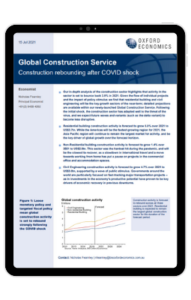Global construction rebounding after COVID shock

Our in-depth analysis of the construction sector highlights that activity in the sector is set to bounce back 3.9% in 2021. Given the flow of individual projects and the impact of policy stimulus we find that residential building and civil engineering will be the key growth sectors of the near-term; detailed projections are available within our newly-launched Global Construction Service. Following the initial shock, the construction sector has adapted well to the threat of the virus, and we expect future waves and variants (such as the delta variant) to become less disruptive.
What you will learn:
- Residential building construction activity is forecast to grow 5.0% over 2021 to US$3.7tn. While the Americas will be the fastest growing region for 2021, the Asia Pacific region will continue to remain the largest market for activity, and be the key driver of global growth over the forecast horizon.
- Non-Residential building construction activity is forecast to grow 1.4% over 2021 to US$2.5tn. This sector was the hardest hit during the pandemic, and will be the slowest to recover, as a slowdown in international travel and a move towards working from home has put a pause on projects in the commercial office and accommodation spaces.
- Civil Engineering construction activity is forecast to grow 4.7% over 2021 to US$3.0tn, supported by a wave of public stimulus. Governments around the world are particularly focused on fast-tracking major transportation projects – as in investments in the economy’s productive potential have proven to be key drivers of economic recovery in previous downturns.
Tags:
Related Services

Post
House prices continue to slide for China’s cities
Research Briefing Global construction rebounding after COVID shock While the property market downturn has been universal, the scale and depth has been varied for different cities and regions.
Find Out More
Post
The Construction Productivity Challenge in Australia
Delve into the state of construction productivity in Australia. Understand the factors affecting growth and how innovation can transform the industry for the better.
Find Out More